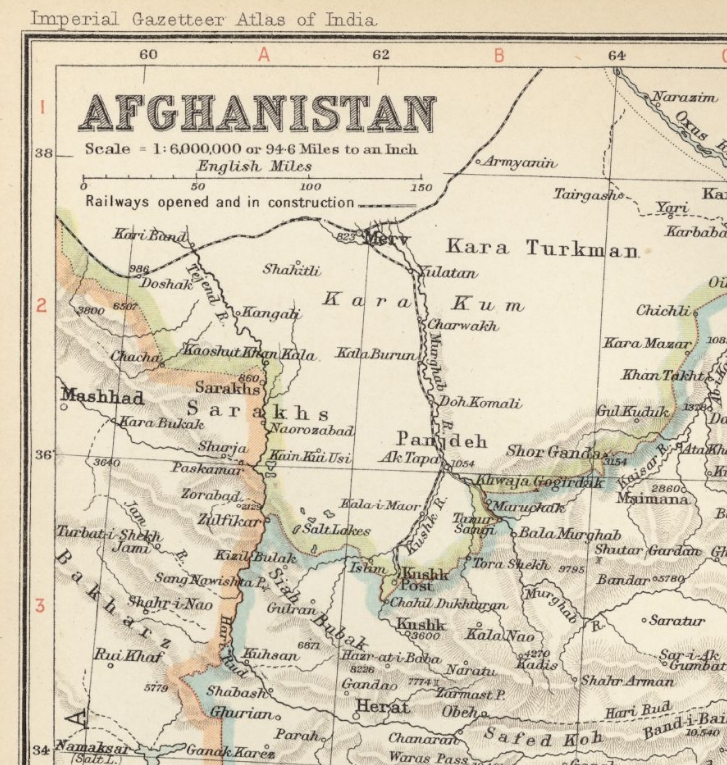Previous page: The Great Game
In 1897-98 imperial Russia built a branch line to the Afghan frontier from Merv (now Mary) on the Trans-Caspian railway.
The line ran for 293 versts (313 km) along the valleys of the Murghab and Kushk rivers to terminate at Kushkinski Post, a military outpost founded in 1890 which became the southernmost point of the Russian empire and the nucleus of the town of Kushka (now Sehetabat).
Imperial Gazetteer of India map of Afghanistan from 1909 showing the Russia railway from Merv (Mary) to Kushka (Serhetabat). (Source: Digital South Asia Library)
Work on the railway started on 15 November 1897, and it was opened on 4 December 1898.1 However the tracks did not cross into Afghanistan.
The new line was controlled by the Russian military, and in 1900 Russia’s Minister of War conducted an experiment in which a detachment of troops travelled by rail from Tiflis (now Tbilisi) to Baku, then by ship across the Caspian Sea to Krasnovodsk, and then by rail to Kushka. This experiment showed that troops could move from the Caucasus to the Afghan border in eight days.2
The fact that a railway 220 miles long, directly threatening Herat, Afghanistan, has been built, almost one might say secretly, is astonishing in these days of telegraph and newspapers. The line was commenced some two years ago, but all allusions to it were scoffed at in St. Petersburg.
Russia’s secret railroad, Deseret Evening News, 8 April 1899
Construction of the railway caused concern in Britain and British-ruled India.
Some Britons feared that Russia might soon extend the railway from Kushka to Herat, a major city with plentiful food and water which would be a useful staging post for any Russian military attempt to threaten India, either as an end in itself or as a way of tying up British resources to enable Russia to apply pressure against Britain in Europe or elsewhere in the world.
Some people in Britain advocated that the Indian railway to Chaman near Afghanistan’s southern border should be extended through to Kandahar. This would enable British and Indian troops to be rushed to Afghanistan to meet any perceived Russian threat, and to ensure that any fighting would be at a safe distance from British India itself.
… reflect that if the future brings war between England and Russia its roaring tide will flow over these very rails for the invasion of India, and that if it brings peace [Merv] will be a station on the through line between Calais and Kandahar.
The Russian March on India. A secret railway line, Henry Norman MP, Scribener’s Magazine, 1901
However the Afghan government — perhaps understandably — strongly opposed plans for foreigners to build railways on Afghan territory, and neither of the rival empires built lines across their frontiers.
The USSR eventually extended the railway by a short distance to serve a freight terminal which was built on the Afghan side of the border at Turghondi. I have not been able to pin down when the extension was constructed, but it was possibly in the 1960s.
Proposals for a railway extension from Chaman in Pakistan to the Afghan border town of Spin Boldak and on to the city of Kandahar are still discussed today.
Next page: Kabul River and Loi Shilman railways
References
- Хронология событий, Ministry of Railway Transport of Turkmenistan ↩
- Russia And Afghanistan. Through Reuter’s Agency. The Times, 8 Jan 1900; p4. Issue 36033, col B. ↩
